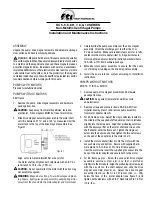
User Manual 10H52258UM60 - Rev. 3 - 01/2019
50
APM 400/600
Introducing UPS Operations
Battery Circuit Breaker (BCB)
The external battery is connected to the UPS via the BCB. The (optional) BCB box must be installed close to the
battery. It must be a manually operated breaker switch, and be fitted with a shunt tripping coil. When the system
is faulty and the switches need to be disconnected, the UPS control circuit will send a signal to the shunt tripping
coil in order to trip the BCB. It must also feature a magnetic trip for overload protection.
Parallel System
Up to four UPS modules may be connected in parallel in order to increase the system capacity and reliability. The
load is distributed equally between the parallel-connected UPS modules.
Also, two UPS modules or parallel systems may be used to form a dual bus system, where each module or parallel
system has its own, independent output. The outputs are synchronized by means of the LBS cable or LBS device,
thus enabling seamless load transfer between the two parallel systems or modules via the STS device.
Parallel System Features
1. With the exception of the load sharing inductor assembly and parallel communication cables, the hardware and
software of parallel systems are identical to those of individual modules. The parallel system configuration is
achieved through settings in the configuration software.
2. Parallel cables are connected in a ring, providing both system reliability and redundancy.
Dual bus control cables are connected between any two UPS modules of each bus. The intelligent parallel logic
provides the user with maximum flexibility. For example, UPS modules in a parallel system may be shut down or
started up in any sequence. Transfers between normal and bypass modes of operation are synchronized and
self-recoverable after events such as overloads have been cleared.
3. The total load of the parallel system can be queried from the LCD on each module.
Parallel System Requirements
A group of modules connected in parallel behave as though they were one large UPS, with the advantage of
providing increased reliability. To ensure that all modules are utilized equally, and to comply with relevant wiring
rules, the following requirements shall apply:
1. All UPS modules must be the same series, and connect to the same bypass source.
2. The bypass and rectifier input sources must be connected to the same neutral line input terminal.
3. If any RCD are installed, they be of an appropriate rating, and located upstream of the common neutral line
input terminal. Alternatively, the devices must monitor the protective earth current of the system. Refer to the
High Earth Leakage Current Warning, which appears before the Contents section of this manual.
4. In the case of parallel system consisting of two or more UPS modules, the (optional) bypass load sharing
inductors should be installed.
Operating Modes
The various APM UPS operating modes are listed below:
•
Normal mode
•
Battery mode
•
Automatic restart mode
•
Bypass mode
•
Maintenance mode
•
ECO mode
•
Frequency converter mode
•
Dormancy mode
•
LBS mode
Normal mode
The mains is converted from AC to DC by the UPS rectifier, the DC power, which is also used to recharge the
battery, is then fed to the inverter where it is reconverted to AC in order to provide an uninterrupted supply of
power to the loads.
The block diagram in Figure 6-3 illustrates Normal Mode:
Содержание Liebert APM 400
Страница 1: ...Liebert APM 400 600kW User Manual ...
Страница 2: ...APM 400 600 UNINTERRUPTIBLE POWER SUPPLY USER MANUAL 10H52258UM60 rev 3 ...
Страница 3: ......
















































